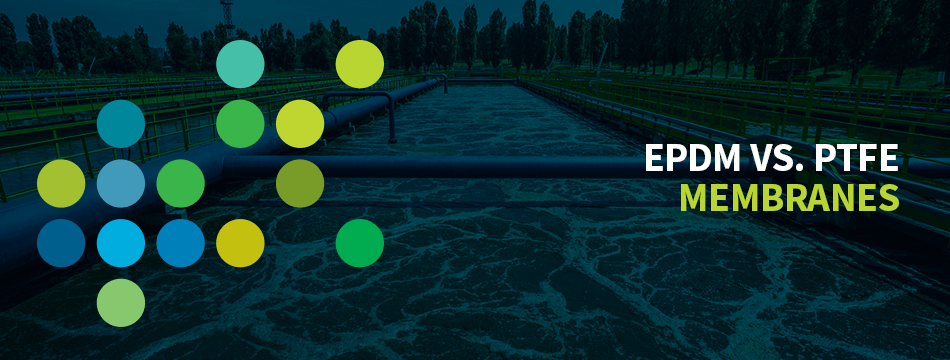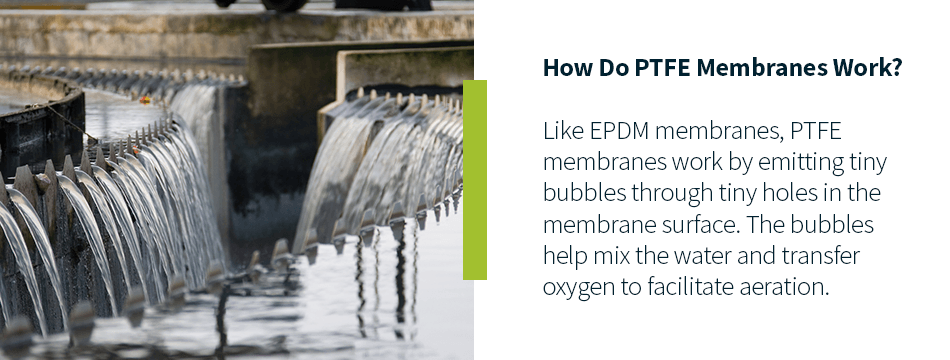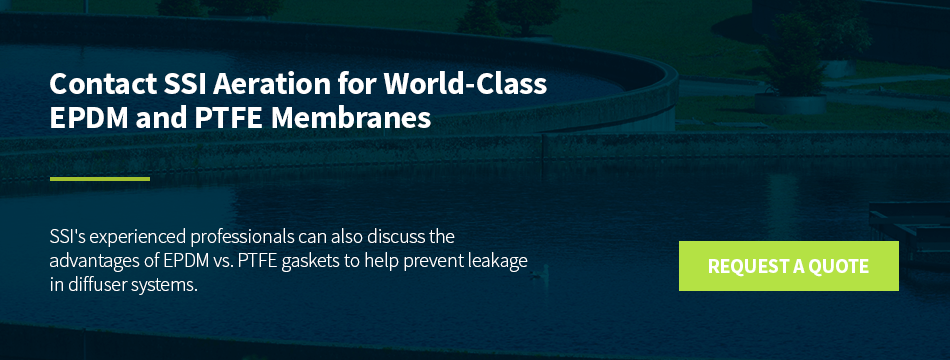EPDM vs. PTFE Membranes
By: Tom Frankel
Post Date: marzo 3rd 2020

Table Of Contents
- What Are EPDM Membranes?
- What Are PTFE Membranes?
- Choosing the Right Membranes for Your Application
- Contact SSI Aeration for World-Class EPDM and PTFE Membranes
Many wastewater diffusers use perforated membranes to diffuse oxygen into the wastewater during aeration. EPDM is a common membrane material, as is PTFE. Both types of membranes offer superior performance and enhanced standard aeration efficiency (SAE) and oxygen transfer efficiency (OTE) for efficient, effective aeration over many years of operation.Because the aeration system typically uses 50 to 65% of the power consumed at a standard activated sludge wastewater treatment plant, according to the EPA, it’s important to select diffuser membranes that work efficiently and last durably to keep both energy and monetary costs low.
But what is the difference between EPDM and PTFE membranes? Below is a discussion of some of the pros and cons of PTFE vs. EPDM membranes to help consumers choose the right membranes for specific applications.
What Are EPDM Membranes?
An EPDM membrane is a wastewater aeration diffuser membrane made from EPDM rubber, a synthetic rubber composed of ethylene, propylene and a diene monomer. It has a relatively low density and high heat capacity.
How Do EPDM Membranes Work?
EPDM full form membranes work by fitting over an aeration diffuser that emits tiny bubbles through small perforations on the membrane surface. Because EPDM is relatively soft and pliable, the minuscule orifices are flexible enough to expand to emit a bubble and then contract to prevent the backflow of water. The small bubbles transfer oxygen to the wastewater column and allow aeration to proceed.
Pros of EPDM Membranes
Below are some of the advantages of EPDM membranes:
- Robust heat and light resistance: Because EPDM has a saturated polymer backbone, it has a strong resistance to heat and light and holds up well under hot water temperatures, steam and bright conditions. These qualities mean that EPDM membranes have a long lifespan and can last for years without degradation in hot industrial wastewater. They are also resistant to damage from extreme weather.
- Effectiveness with a variety of substances: EPDM membranes work well with polar substances such as water, alkali substances and even some hydraulic fluids that may be found in wastewater.
- Cost: EPDM membranes tend to be more economical than PTFE membranes. Plants that need to fit their aeration diffusers into a tight budget will likely want to invest in EPDM membranes for their reliable performance at a lower cost.
Cons of EPDM Membranes
Below are some of the disadvantages of using EPDM membranes:
- Swelling when stagnant in water: EPDM membranes are not hydrophobic, so they can admit water. SSI’s in-house experiments, as well as more rigorous tests done in a variety of different industries, show that EPDM membranes sometimes swell when left stagnant in water for an extended period. One possible explanation is that EPDM membranes with long lifespans last for so long because they are constantly moving in the wastewater. Because of this, water cannot saturate the membrane and lead to swelling, cracking and changes in hardness and thickness. But membranes that are sometimes turned off and allowed to soak are susceptible to these detrimental effects.
- Detrimental aging effects: As EPDM membranes age and wear out, they are likely to experience plasticizer leakage and creep. The surface area over which bubbles form may also diminish, resulting in decreased oxygen transfer efficiency (OTE). Protective coatings can help reduce this issue, however.
- Susceptibility to biological fouling: EPDM membranes are more susceptible to biological fouling than their PTFE counterparts. Protective coatings can help reduce this issue as well.
ASK AN EXPERTCALL US AT (845) 454-8171REQUEST A QUOTE
What Are PTFE Membranes?
PTFE is a thermoplastic polymer. It is made from synthetic fluorine-containing polymers and is known for its toughness and self-lubricating qualities. One of the best-known PTFE materials is Teflon, famous for its nonstick properties. PTFE has a relatively high density and a relatively low tensile strength.
On its own, PTFE has a number of uses across different industries—its nonstick properties are even useful in hospital equipment to prevent the aggregation of bacteria and minimize the risk of hospital infections.
Because of their density, PTFE membranes are harder than EPDM membranes. They can resist breakdown and foiling because their surfaces are harder to penetrate.
How Do PTFE Membranes Work?

Like EPDM membranes, PTFE membranes work by emitting tiny bubbles through tiny holes in the membrane surface. The bubbles help mix the water and transfer oxygen to facilitate aeration.
Often, PTFE membranes consist of a protective PTFM coating over an inner layer of EPDM. This multilayer construction can help preserve old EPDM membranes by giving them an extra coating instead of replacing them entirely at great expense in both money and time. It allows for greater cost-effectiveness than using PTFE alone.
Pros of PTFE Membranes
Below are some of the advantages of PTFE membranes:
- Reduced fouling and cleaning frequency: PTFE membranes can help slow the rate of membrane fouling, often by a factor of five to 10 when compared with EPDM membranes. This advantage occurs because of the nonstick properties of PTFE, which make it hard for organic matter to adhere to and accumulate on the PTFE surface. This property also means that PTFE membranes require less frequent cleaning than EPDM membranes.
- Reduced swelling: As mentioned above, EPDM membranes tend to swell and crack when left stationary in water. PTFE membranes are much less vulnerable to this effect because of their hydrophobic properties. SSI engineers first noticed this durability in an impromptu in-house experiment when they left EPDM and PTFE membranes to soak in water over an extended time. Later tests took place across a range of different applications in different industries — perfume factories, textile factories, paper mills, pharmaceutical plants, oil refineries and municipal wastewater treatment plants. In none of these scenarios did the PTFE membranes swell, crack and deform as EPDM membranes would have.
- Fewer detrimental effects due to aging: When PTFE ages, it is also less likely to see plasticizer creep or a reduced bubbling area. Old, used PTFE membranes retain their reliable OTE for consistent aeration performance.
Cons of PTFE Membranes
Below are some of the disadvantages of PTFE membranes:
- Higher cost: PTFE membranes tend to cost more than EPDM membranes. Plants will need to consider their wastewater composition and facility usage patterns to determine whether the many benefits of PTFE membranes are worth the extra upfront expenditures.
- Decomposition with certain substances: In the presence of acetone or hot alkaline substances, PTFE membranes tend to break down, so they are less suitable for wastewater with high concentrations of these substances. When PTFE breaks down, it produces carbon dioxide and hydrogen fluoride, the latter of which is highly corrosive and could harm the aeration equipment.
However, wastewater treatment facilities can diminish the disadvantages of PTFE through the use of specialized coatings. Using protective coatings helps PTFE membranes resist fouling and perform well in many types of wastewater.
Choosing the Right Membranes for Your Application
Wastewater treatment plants should consider a few different factors when deciding between EPDM and PTFE membranes:
- Wastewater composition: Plants with a high level of biological contaminants in their wastewater will likely choose PTFE membranes, whereas plants with extremely hot or steamy wastewater or wastewater with a high concentration of acetone or alkaline substances should choose PTFE membranes.
- Continuous or discontinuous operation: As suggested above, EPDM membranes have much longer lifespans when they run constantly. If a plant intends to run its aeration systems nonstop, EPDM membranes can make an ideal choice. If the plant intends to shut its aerator off at regular intervals, PTFE membranes will make a more suitable choice. They will not swell, crack or change shape due to saturation with water when not in use.
- Budget: Plants operating on stricter budgets will likely want to choose the more economical EPDM membranes. Plants that have roomier budgets and plants for which the durability of PTFE offsets the higher initial cost may want to choose PTFE membranes instead.
- Projected lifespan: Plants that need their membranes to remain at their peak performance over a long timespan without requiring maintenance or replacement will likely want to choose PTFE membranes, even though the upfront costs will be higher.
Contact SSI Aeration for World-Class EPDM and PTFE Membranes
 For the best-quality EPDM and PTFE diffuser membranes on the market, partner with SSI Aeration. SSI offers easy-to-install PODS systems for plants that want to do their own installation and can also install new aeration diffuser systems or retrofit an existing system with modern membrane updates. SSI’s experienced professionals can also discuss the advantages of EPDM vs. PTFE gaskets to help prevent leakage in diffuser systems.
For the best-quality EPDM and PTFE diffuser membranes on the market, partner with SSI Aeration. SSI offers easy-to-install PODS systems for plants that want to do their own installation and can also install new aeration diffuser systems or retrofit an existing system with modern membrane updates. SSI’s experienced professionals can also discuss the advantages of EPDM vs. PTFE gaskets to help prevent leakage in diffuser systems.
Contact us today to learn more.
ASK AN EXPERTCALL US AT (845) 454-8171REQUEST A QUOTE

Mr. Frankel co-founded SSI in 1995 with experience in design and distribution of engineered systems. He is in charge of sales, marketing and operations in the company. Mr. Frankel holds multiple US patents related to diffusers. He is a graduate of Washington University in St. Louis.

